Dating Agricultural Terraces in the Mediterranean Using Luminescence: Recent Progress and Challenges
Abstract
1. Introduction
2. Radiocarbon Dating
3. Luminescence Dating
4. OSL Dating of Terrace Sediments: Current Challenges and Misconceptions
4.1. Viability of Luminescence Signal for Dating
4.2. Partial Bleaching of Terrace Sediments
4.3. Overdispersion and Choosing the Right Dose Model
4.4. Choosing the Right Water Content Value for Dosimetry
5. Multidisciplinarity: The Way Forward
5.1. Identifying the Best Sites for OSL Dating
5.2. Combining OSL Profiling and Dating
5.3. Interrogating Micromorphological Data with Luminescence Chronology
6. Conclusions
Author Contributions
Funding
Data Availability Statement
Acknowledgments
Conflicts of Interest
References
- Bradford, J. Ancient Landscapes: Studies in Field Archaeology; Bell: London, UK, 1957. [Google Scholar]
- Spencer, J.E.; Hale, G.A. The origin, nature, and distribution of agricultural terracing. Pac. Viewp. 1961, 2, 1–40. [Google Scholar] [CrossRef]
- Correia, T. Land abandonment: Changes in the land use patterns around the Mediterranean basin. Cah. Options Méditerr. 1993, 1, 97–112. [Google Scholar]
- French, C.A.; Whitelaw, T.M. Soil erosion, agricultural terracing and site formation processes at Markiani, Amorgos, Greece: The micromorphological perspective. Geoarchaeology 1999, 14, 151–189. [Google Scholar] [CrossRef]
- Grove, A.T.; Rackham, O. The Nature of Mediterranean Europe: An Ecological History; Yale University Press: London, UK, 2003. [Google Scholar]
- Bevan, A.; Conolly, J. Terraced fields and Mediterranean landscape structure: An analytical case study from Antikythera, Greece. Ecol. Model. 2011, 222, 1303–1314. [Google Scholar] [CrossRef]
- Bevan, A.; Conolly, J.; Colledge, S.; Frederick, C.; Palmer, C.; Siddall, R.; Stellatou, A. The long-term ecology of agricultural terraces and enclosed fields from Antikythera, Greece. Hum. Ecol. 2013, 41, 255–272. [Google Scholar] [CrossRef]
- Rackham, O.; Moody, J.; Nixon, L.; Price, S. Some field systems in Crete. Br. Sch. Athens Stud. 2010, 18, 269–284. [Google Scholar]
- Petanidou, T.; Kizos, T.; Soulakellis, N. Socioeconomic dimensions of changes in the agricultural landscape of the Mediterranean basin: A case study of the abandonment of cultivation terraces on Nisyros Island, Greece. Environ. Manag. 2008, 41, 250–266. [Google Scholar] [CrossRef]
- García-Ruiz, J.M.; Lana-Renault, N. Hydrological and erosive consequences of farmland abandonment in Europe, with special reference to the Mediterranean region—A review. Agric. Ecosyst. Environ. 2011, 140, 317–338. [Google Scholar] [CrossRef]
- Gibson, S. Agricultural terraces and settlement expansion in the highlands of early Iron Age Palestine: Is there any correlation between the two? In Studies in the Archaeology of the Iron Age in Israel and Jordan; A&C Black: London, UK, 2001; pp. 113–146. [Google Scholar]
- Kemp, R.; Branch, N.; Silva, B.; Meddens, F.; Williams, A.; Kendall, A.; Vivanco, C. Pedosedimentary, cultural and environmental significance of paleosols within pre-hispanic agricultural terraces in the southern Peruvian Andes. Quat. Int. 2006, 158, 13–22. [Google Scholar] [CrossRef]
- Borejsza, A.; López, I.R.; Frederick, C.D.; Bateman, M.D. Agricultural slope management and soil erosion at La Laguna, Tlaxcala, Mexico. J. Archaeol. Sci. 2008, 35, 1854–1866. [Google Scholar] [CrossRef]
- Acabado, S. A Bayesian approach to dating agricultural terraces: A case from the Philippines. Antiquity 2009, 83, 801–814. [Google Scholar] [CrossRef]
- Henck, A.; Taylor, J.; Lu, H.; Li, Y.; Yang, Q.; Grub, B.; Breslow, S.J.; Robbins, A.; Elliott, A.; Hinckley, T.; et al. Anthropogenic hillslope terraces and swidden agriculture in Jiuzhaigou National Park, northern Sichuan, China. Quat. Res. 2010, 73, 201–207. [Google Scholar] [CrossRef]
- Jiang, Y.; Li, S.; Cai, D.; Chen, W.; Liu, Y.; Yu, Z. The genesis and paleoenvironmental records of Longji agricultural terraces, southern China: A pilot study of human–environment interaction. Quat. Int. 2014, 321, 12–21. [Google Scholar] [CrossRef]
- Jiang, Y.; Li, S.; Chen, W.; Cai, D.; Liu, Y. The evolution of crop cultivation and paleoenvironment in the Longji Terraces, southern China: Organic geochemical evidence from paleosols. J. Environ. Manag. 2017, 202, 524–531. [Google Scholar] [CrossRef]
- Agnoletti, M.; Conti, L.; Frezza, L.; Santoro, A. Territorial analysis of the agricultural terraced landscapes of Tuscany (Italy): Preliminary results. Sustainability 2015, 7, 4564–4581. [Google Scholar] [CrossRef]
- Lasanta, T.; Arnáez, J.; Oserín, M.; Ortigosa, L.M. Marginal lands and erosion in terraced fields in the Mediterranean mountains. Mt. Res. Dev. 2001, 21, 69–76. [Google Scholar] [CrossRef]
- Ales, R.F.; Martin, A.; Ortega, F.; Ales, E.E. Recent changes in landscape structure and function in a Mediterranean region of SW Spain (1950–1984). Landsc. Ecol. 1992, 7, 3–18. [Google Scholar] [CrossRef]
- Tarolli, P.; Rizzo, D.; Brancucci, G. Terraced landscapes: Land abandonment, soil degradation, and suitable management. In World Terraced Landscapes: History, Environment, Quality of Life; Springer: Berlin/Heidelberg, Germany, 2019; pp. 195–210. [Google Scholar]
- Moreno-de-las-Heras, M.; Lindenberger, F.; Latron, J.; Lana-Renault, N.; Llorens, P.; Arnáez, J.; Romero-Díaz, A.; Gallart, F. Hydro-geomorphological consequences of the abandonment of agricultural terraces in the Mediterranean region: Key controlling factors and landscape stability patterns. Geomorphology 2019, 333, 73–91. [Google Scholar] [CrossRef]
- Turner, S.; Crow, J. Unlocking historic landscapes in the Eastern Mediterranean: Two pilot studies using Historic Landscape Characterisation. Antiquity 2010, 84, 216–229. [Google Scholar] [CrossRef]
- Crow, J.; Turner, S.; Vionis, A.K. Characterizing the historic landscapes of Naxos. J. Mediterr. Archaeol. 2011, 24, 111–137. [Google Scholar] [CrossRef]
- Frederick, C.D.; Krahtopoulou, A. Deconstructing agricultural terraces: Examining the influence of construction method on stratigraphy, dating and archaeological visibility. In Landscape and Land Use in Postglacial Greece; A&C Black: London, UK, 2000; pp. 79–94. [Google Scholar]
- Wilkinson, T.J. Archaeological Landscapes of the Near East; University of Arizona Press: Tucson, AZ, USA, 2003. [Google Scholar]
- Gibson, S. The Archaeology of Agricultural Terraces in the Mediterranean zone of the southern Levant and the use of the optically stimulated luminescence (OSL) dating method. In Soils and Sediments as Archives of Landscape Change: Geoarchaeology and Landscape Change in the Subtropics and Tropics (Erlanger Geographische Arbeiten42); ACADEMIA: San Francisco, CA, USA, 2015; pp. 295–314. [Google Scholar]
- Price, S.; Nixon, L. Ancient Greek agricultural terraces: Evidence from texts and archaeological survey. Am. J. Archaeol. 2005, 109, 665–694. [Google Scholar] [CrossRef]
- Lavento, M. Archaeological investigations of ancient water systems in Jordan. In Transference. Interdisciplinary Communications 2008/2009; CAS: Oslo, Norway, 2010. [Google Scholar]
- Lavento, M.; Huotari, M. A water management system around Jabal Harun, Petra–its design and significance. In Proceedings of the 11th International Conference on the History of Water Management and Hydraulic Engineering in the Mediterranean Region, Israel, 7–12 May 2001; Volume 1, pp. 93–106. [Google Scholar]
- Kouki, P. Archaeological Evidence of Land Tenure in the Petra Region, Jordan: Nabataean-Early Roman to Late Byzantine. J. Mediterr. Archaeol. 2009, 22, 29–56. [Google Scholar] [CrossRef]
- Lee, W.E. Pylos regional archaeological project, part IV: Change and the human landscape in a modern Greek village in Messenia. Hesperia 2001, 70, 49–98. [Google Scholar] [CrossRef]
- Krahtopoulou, A.; Frederick, C. The stratigraphic implications of long-term terrace agriculture in dynamic landscapes: Polycyclic terracing from Kythera Island, Greece. Geoarchaeology Int. J. 2008, 23, 550–585. [Google Scholar] [CrossRef]
- Quirós-Castillo, J.A.; Nicosia, C. Reconstructing past terraced agrarian landscapes in the Ebro Valley: The deserted village of Torrentejo in the Basque Country, Spain. Geoarchaeology 2019, 34, 684–697. [Google Scholar] [CrossRef]
- Kiesow, S.; Bork, H.R. Agricultural terraces as a proxy to landscape history on Madeira island, Portugal. Ler História 2017, 31, 127–152. [Google Scholar] [CrossRef]
- Brown, A.; Walsh, K.; Fallu, D.; Cucchiaro, S.; Tarolli, P. European agricultural terraces and lynchets: From archaeological theory to heritage management. World Archaeol. 2020, 52, 566–588. [Google Scholar] [CrossRef] [PubMed]
- Betancourt, P.P.; Hope Simpson, R. The agricultural system of Bronze age Pseira. Cretan Stud. 1992, 3, 47–54. [Google Scholar]
- Rackham, O.; Moody, J. The Making of the Cretan Landscape; Manchester University Press: Manchester, UK, 1996. [Google Scholar]
- Bayliss, A. Rolling out revolution: Using radiocarbon dating in archaeology. Radiocarbon 2009, 51, 123–147. [Google Scholar] [CrossRef]
- Taylor, R.E.; Bar, O. Radiocarbon Dating: An Archaeological Perspective. Am. J. Archaeol. 2018, 122. [Google Scholar] [CrossRef]
- Beckers, B.; Berking, J.; Schütt, B. Ancient water harvesting methods in the drylands of the Mediterranean and Western Asia. Etopoi. J. Anc. Stud. 2013. [Google Scholar] [CrossRef]
- Rendu, C.; Passarrius, O.; Calastrenc, C.; Julia, R.; Llubes, M.; Illes, P.; Campmajo, P.; Jodry, C.; Crabol, D.; Bille, E.; et al. Reconstructing past terrace fields in the Pyrenees: Insights into land management and settlement from the Bronze Age to the Early Modern era at Vilalta (1650 masl, Cerdagne, France). J. Field Archaeol. 2015, 40, 461–480. [Google Scholar] [CrossRef]
- Puy, A.; Balbo, A.L.; Bubenzer, O. Radiocarbon dating of agrarian terraces by means of buried soils. Radiocarbon 2016, 58, 345–363. [Google Scholar] [CrossRef]
- González Reyero, S.; Sánchez-Palencia, F.J.; López-Sáez, J.A.; Pérez-Díaz, S.; Ruiz-Alonso, M.; Romero Perona, D.; Vallés Iriso, J.; Álvarez-Ayuso, E. Agrarian landscapes in the Iberian Iron Age: Mountain communities and land use in southeastern Iberia. Geoarchaeology 2019, 34, 252–271. [Google Scholar] [CrossRef]
- Bruins, H.J.; van der Plicht, J. Iron Age Agriculture-A Critical Rejoinder to “Settlement Oscillations in the Negev Highlands Revisited: The Impact of Microarchaeological Methods”. Radiocarbon 2017, 59, 1. [Google Scholar] [CrossRef]
- Bruins, H.J.; Van Der Plicht, J.; Haiman, M. Desert habitation history by 14C dating of soil layers in rural building structures (Negev, Israel): Preliminary results from Horvat Haluqim. Radiocarbon 2012, 54, 391–406. [Google Scholar] [CrossRef]
- Puy, A.; Balbo, A.L. The genesis of irrigated terraces in al-Andalus. A geoarchaeological perspective on intensive agriculture in semi-arid environments (Ricote, Murcia, Spain). J. Arid Environ. 2013, 89, 45–56. [Google Scholar] [CrossRef]
- Ferro-Vázquez, C.; Martínez-Cortizas, A.; Nóvoa-Muñoz, J.C.; Ballesteros-Arias, P.; Criado-Boado, F. 1500 years of soil use reconstructed from the chemical properties of a terraced soil sequence. Quat. Int. 2014, 346, 28–40. [Google Scholar] [CrossRef]
- Ferro-Vázquez, C.; Kaal, J.; Santos Arévalo, F.; Criado Boado, F. Molecular fingerprinting of 14C dated soil organic matter fractions from archaeological settings in NW Spain. Radiocarbon 2018, 61, 101–130. [Google Scholar] [CrossRef]
- Pessenda, L.C.; Gouveia, S.E.; Aravena, R. Radiocarbon dating of total soil organic matter and humin fraction and its comparison with 14C ages of fossil charcoal. Radiocarbon 2001, 43, 595–601. [Google Scholar] [CrossRef]
- Buck, C.E.; Cavanagh, W.G.; Litton, C.D. Bayesian Approach to Interpreting Archaeological Data; Wiley Chichester: Chichester, UK, 1996. [Google Scholar]
- Gadot, Y.; Davidovich, U.; Avni, G.; Avni, Y.; Piasetzky, M.; Faershtein, G.; Golan, D.; Porat, N. The formation of a Mediterranean terraced landscape: Mount Eitan, Judean Highlands, Israel. J. Archaeol. Sci. Rep. 2016, 6, 397–417. [Google Scholar] [CrossRef]
- Gillespie, R.; Prosser, I.P.; Dlugokencky, E.; Sparks, R.J.; Wallace, G.; Chappell, J. AMS dating of alluvial sediments on the southern tablelands of New South Wales, Australia. Radiocarbon 1992, 34, 29–36. [Google Scholar] [CrossRef]
- Beckers, B.; Schütt, B.; Tsukamoto, S.; Frechen, M. Age determination of Petra’s engineered landscape–optically stimulated luminescence (OSL) and radiocarbon ages of runoff terrace systems in the Eastern Highlands of Jordan. J. Archaeol. Sci. 2013, 40, 333–348. [Google Scholar] [CrossRef]
- Silva-Sánchez, N.; Kinnaird, T.; Fernández-Ferreiro, M.; López-Salas, E.; Turner, S.; Sánchez-Pardo, J.-C. Written in soil and paper. Investigating environmental transformations of a monastic landscape by combining geoarchaeology and palynology with historical analysis at Samos (Galicia). J. Archaeol. Sci. Rep. 2022, 45, 103575. [Google Scholar]
- Kinnaird, T.; Bolos, J.; Turner, A.; Turner, S. Optically-stimulated luminescence profiling and dating of historic agricultural terraces in Catalonia (Spain). J. Archaeol. Sci. 2017, 78, 66–77. [Google Scholar] [CrossRef]
- Porat, N.; Davidovich, U.; Avni, Y.; Avni, G.; Gadot, Y. Using OSL measurements to decipher soil history in archaeological terraces, Judean Highlands, Israel. Land Degrad. Dev. 2018, 29, 643–650. [Google Scholar] [CrossRef]
- Aitken, M.J. Introduction to Optical Dating: The Dating of Quaternary Sediments by the Use of Photon-Stimulated Luminescence; Clarendon Press: Oxford, UK, 1998. [Google Scholar]
- Duller, G.A. Single-grain optical dating of Quaternary sediments: Why aliquot size matters in luminescence dating. Boreas 2008, 37, 589–612. [Google Scholar] [CrossRef]
- Granger, D.E.; Muzikar, P.F. Dating sediment burial with in situ-produced cosmogenic nuclides: Theory, techniques, and limitations. Earth Planet. Sci. Lett. 2001, 188, 269–281. [Google Scholar] [CrossRef]
- Walsh, K.; Berger, J.F.; Roberts, C.N.; Vanniere, B.; Ghilardi, M.; Brown, A.G.; Woodbridge, J.; Lespez, L.; Estrany, J.; Glais, A.; et al. Holocene demographic fluctuations, climate and erosion in the Mediterranean: A meta data-analysis. Holocene 2019, 29, 864–885. [Google Scholar] [CrossRef]
- Davidovich, U.; Porat, N.; Gadot, Y.; Avni, Y.; Lipschits, O. Archaeological investigations and OSL dating of terraces at Ramat Rahel, Israel. J. Field Archaeol. 2012, 37, 192–208. [Google Scholar] [CrossRef]
- Meister, J.; Krause, J.; Müller-Neuhof, B.; Portillo, M.; Reimann, T.; Schütt, B. Desert agricultural systems at EBA Jawa (Jordan): Integrating archaeological and paleoenvironmental records. Quat. Int. 2017, 434, 33–50. [Google Scholar] [CrossRef]
- Avni, Y.; Porat, N.; Avni, G. Pre-farming environment and OSL chronology in the Negev Highlands, Israel. J. Arid Environ. 2012, 86, 12–27. [Google Scholar] [CrossRef]
- Avni, G.; Porat, N.; Avni, Y. Byzantine–Early Islamic agricultural systems in the Negev Highlands: Stages of development as interpreted through OSL dating. J. Field Archaeol. 2013, 38, 332–346. [Google Scholar] [CrossRef]
- Gadot, Y.; Davidovich, U.; Avni, Y.; Avni, G.; Porat, N. The Formation of Terraced Landscapes in the Judean Highlands in Israel, and its Implications for Biblical Agricultural History. Hebr. Bible Anc. Isr. 2016, 5, 437–455. [Google Scholar] [CrossRef]
- Porat, N.; López, G.I.; Lensky, N.; Elinson, R.; Avni, Y.; Elgart-Sharon, Y.; Faershtein, G.; Gadot, Y. Using portable OSL reader to obtain a time scale for soil accumulation and erosion in archaeological terraces, the Judean Highlands, Israel. Quat. Geochronol. 2019, 49, 65–70. [Google Scholar] [CrossRef]
- Stavi, I.; Ragolsky, G.; Haiman, M.; Porat, N. Ancient to recent-past runoff harvesting agriculture in the hyper-arid Arava Valley: OSL dating and insights. Holocene 2021, 31, 1047–1054. [Google Scholar] [CrossRef]
- Turner, S.; Kinnaird, T.; Varinlioğlu, G.; Şerifoğlu, T.; Koparal, E.; Demirciler, V.; Athanassoulis, D.; Ødegård, K.; Crow, J.; Jackson, M.; et al. Agricultural terraces in the Mediterranean: Intensive construction during the later Middle Ages revealed by landscape analysis with OSL profiling and dating. Antiquity 2021, 95, 773–790. [Google Scholar] [CrossRef]
- French, C.; Taylor, S.; McLaughlin, R.; Cresswell, A.; Kinnaird, T.; Sanderson, D.; Stoddart, S.; Malone, C. A Neolithic palaeo-catena for the Xagħra Upper Coralline Limestone plateau of Gozo, Malta, and its implications for past soil development and land use. Catena 2018, 171, 337–358. [Google Scholar] [CrossRef]
- Singarayer, J.S.; Bailey, R.M. Further investigations of the quartz optically stimulated luminescence components using linear modulation. Radiat. Meas. 2003, 37, 451–458. [Google Scholar] [CrossRef]
- Li, B.; Li, S.H. Comparison of De estimates using the fast component and the medium component of quartz OSL. Radiat. Meas. 2006, 41, 125–136. [Google Scholar] [CrossRef]
- Olley, J.M.; Caitcheon, G.G.; Roberts, R.G. The origin of dose distributions in fluvial sediments, and the prospect of dating single grains from fluvial deposits using optically stimulated luminescence. Radiat. Meas. 1999, 30, 207–217. [Google Scholar] [CrossRef]
- Rittenour, T.M. Luminescence dating of fluvial deposits: Applications to geomorphic, palaeoseismic and archaeological research. Boreas 2008, 37, 613–635. [Google Scholar] [CrossRef]
- Bateman, M.D.; Boulter, C.H.; Carr, A.S.; Frederick, C.D.; Peter, D.; Wilder, M. Preserving the palaeoenvironmental record in drylands: Bioturbation and its significance for luminescence-derived chronologies. Sediment. Geol. 2007, 195, 5–19. [Google Scholar] [CrossRef]
- Nathan, R.P.; Thomas, P.J.; Jain, M.; Murray, A.S.; Rhodes, E.J. Environmental dose rate heterogeneity of beta radiation and its implications for luminescence dating: Monte Carlo modelling and experimental validation. Radiat. Meas. 2003, 37, 305–313. [Google Scholar] [CrossRef]
- Guérin, G.; Christophe, C.; Philippe, A.; Murray, A.S.; Thomsen, K.J.; Tribolo, C.; Urbanová, P.; Jain, M.; Guibert, P.; Mercier, N.; et al. Absorbed dose, equivalent dose, measured dose rates, and implications for OSL age estimates: Introducing the Average Dose Model. Quat. Geochronol. 2017, 41, 163–173. [Google Scholar] [CrossRef]
- Galbraith, R.F.; Roberts, R.G.; Laslett, G.M.; Yoshida, H.; Olley, J.M. Optical dating of single and multiple grains of quartz from Jinmium rock shelter, northern Australia: Part I, experimental design and statistical models. Archaeometry 1999, 41, 339–364. [Google Scholar] [CrossRef]
- Rodnight, H.; Duller, G.A.T.; Wintle, A.G.; Tooth, S. Assessing the reproducibility and accuracy of optical dating of fluvial deposits. Quat. Geochronol. 2006, 1, 109–120. [Google Scholar] [CrossRef]
- Arnold, L.J.; Roberts, R.G. Stochastic modelling of multi-grain equivalent dose (De) distributions: Implications for OSL dating of sediment mixtures. Quat. Geochronol. 2009, 4, 204–230. [Google Scholar] [CrossRef]
- Murray, A.; Arnold, L.J.; Buylaert, J.P.; Guérin, G.; Qin, J.; Singhvi, A.K.; Smedley, R.; Thomsen, K.J. Optically stimulated luminescence dating using quartz. Nat. Rev. Methods Prim. 2021, 1, 72. [Google Scholar] [CrossRef]
- Fairclough, G.; Sarlov-Herlin, I.; Swanwick, C. (Eds.) Routledge Handbook of Landscape Character Assessment; Routledge: London, UK, 2018. [Google Scholar]
- Crow, J.; Turner, S. Silivri and the Thracian hinterland of Istanbul: An historic landscape. Anatol. Stud. 2009, 59, 167–182. [Google Scholar] [CrossRef]
- Turner, S.; Bolòs, J.; Kinnaird, T. Changes and continuities in a Mediterranean landscape: A new interdisciplinary approach to understanding historic character in western Catalonia. Landsc. Res. 2018, 43, 922–938. [Google Scholar] [CrossRef]
- Turner, S. Historic landscape characterisation: An archaeological approach to landscape heritage. In Routledge Handbook of Landscape Character Assessment; Fairclough, G., Sarlov-Herlin, I., Swanwick, C., Eds.; Routledge: London, UK, 2018; pp. 37–50. [Google Scholar]
- Dabaut, N.; Carrer, F. Historic Landscape Characterisation: Technical approaches beyond theory. Landscapes 2020, 21, 152–167. [Google Scholar] [CrossRef]
- Rippon, S. Historic Landscape Analysis: Deciphering the Countryside; Council for British Archaeology: York, UK, 2005. [Google Scholar]
- Oosthuizen, S. Landscapes Decoded; University of Hertfordshire Press: Hertfordshire, UK, 2006. [Google Scholar]
- Doneus, M.; Neubauer, W.; Filzwieser, R.; Sevara, C. Stratigraphy from topography II. The practical application of the Harris Matrix for the GIS-based spatio-temporal archaeological interpretation of topographical data. Archaeol. Austriaca 2022, 106, 223–252. [Google Scholar] [CrossRef]
- Brown, A.G.; Fallu, D.; Walsh, K.; Cucchiaro, S.; Tarolli, P.; Zhao, P.; Pears, B.R.; van Oost, K.; Snape, L.; Lang, A.; et al. Ending the Cinderella status of terraces and lynchets in Europe: The geomorphology of agricultural terraces and implications for ecosystem services and climate adaptation. Geomorphology 2021, 379, 107579. [Google Scholar] [CrossRef]
- Roberts, H.M.; Durcan, J.A.; Duller, G.A. Exploring procedures for the rapid assessment of optically stimulated luminescence range-finder ages. Radiat. Meas. 2009, 44, 582–587. [Google Scholar] [CrossRef]
- Durcan, J.A.; Roberts, H.M.; Duller, G.A.T.; Alizai, A.H. Testing the use of range-finder OSL dating to inform field sampling and laboratory processing strategies. Quat. Geochronol. 2010, 5, 86–90. [Google Scholar] [CrossRef]
- Roberts, H.M.; Duller, G.A. Standardised growth curves for optical dating of sediment using multiple-grain aliquots. Radiat. Meas. 2004, 38, 241–252. [Google Scholar] [CrossRef]
- Telfer, M.W.; Bateman, M.D.; Carr, A.S.; Chase, B.M. Testing the applicability of a standardized growth curve (SGC) for quartz OSL dating: Kalahari dunes, South African coastal dunes and Florida dune cordons. Quat. Geochronol. 2008, 3, 137–142. [Google Scholar] [CrossRef]
- Munyikwa, K.; Kinnaird, T.C.; Sanderson, D.C. The potential of portable luminescence readers in geomorphological investigations: A review. Earth Surf. Process. Landf. 2021, 46, 131–150. [Google Scholar] [CrossRef]
- Boyd, S.L.; Kinnaird, T.C.; Srivastava, A.; Whittaker, J.E.; Bates, C.R. Investigation of coastal environmental change at Ruddons Point, Fife, SE Scotland. Scott. J. Geol. 2022, 58, sjg2022-005. [Google Scholar] [CrossRef]
- Kinnaird, T.; Bates, M.; Bateman, R.; Srivastava, A. Europe’s Lost Frontiers: Volume 1, Context and Methodology; Gaffney, V., Fitch, S., Eds.; Archaeopress: Oxford, UK, 2022; Volume 1, pp. 165–180. 15p. [Google Scholar]
- Sanderson, D.C.; Murphy, S. Using simple portable OSL measurements and laboratory characterisation to help understand complex and heterogeneous sediment sequences for luminescence dating. Quat. Geochronol. 2010, 5, 299–305. [Google Scholar] [CrossRef]
- Stang, D.M.; Rhodes, E.J.; Heimsath, A.M. Assessing soil mixing processes and rates using a portable OSL-IRSL reader: Preliminary determinations. Quat. Geochronol. 2012, 10, 314–319. [Google Scholar] [CrossRef]
- Vervust, S.; Kinnaird, T.; Herring, P.; Turner, S. Optically stimulated luminescence profiling and dating of earthworks: The creation and development of prehistoric field boundaries at Bosigran, Cornwall. Antiquity 2020, 94, 420–436. [Google Scholar] [CrossRef]
- Courty, M.A.; Goldberg, P.; Macphail, R. Soils and Micromorphology in Archaeology; Cambridge University Press: Cambridge, UK, 1989. [Google Scholar]
- Karkanas, P.; Goldberg, P. Reconstructing Archaeological Sites: Understanding the Geoarchaeological Matrix; John Wiley & Sons: Hoboken, NJ, USA, 2019. [Google Scholar]
- Tourloukis, V.; Karkanas, P.; Wallinga, J. Revisiting Kokkinopilos: Middle Pleistocene radiometric dates for stratified archaeological remains in Greece. J. Archaeol. Sci. 2015, 57, 355–369. [Google Scholar] [CrossRef]
- Dakaris, S.I.; Higgs, E.S.; Hey, R.W.; Tippett, H.; Mellars, P. The climate, environment and industries of Stone Age Greece: Part I. Proc. Prehist. Soc. 1964, 30, 199–244. [Google Scholar] [CrossRef]
- Higgs, E.S.; Vita-Finzi, C. The climate, environment and industries of Stone Age Greece: Part II. In Proceedings of the Prehistoric Society; Cambridge University Press: Cambridge, UK, 1966; Volume 32, pp. 1–29. [Google Scholar]
- Van Andel, T.H.; Runnels, C.N. Karstic wetland dwellers of Middle Palaeolithic Epirus, Greece. J. Field Archaeol. 2005, 30, 367–384. [Google Scholar] [CrossRef]
- Karkanas, P.; Shahack-Gross, R.; Ayalon, A.; Bar-Matthews, M.; Barkai, R.; Frumkin, A.; Gopher, A.; Stiner, M.C. Evidence for habitual use of fire at the end of the Lower Paleolithic: Site-formation processes at Qesem Cave, Israel. J. Hum. Evol. 2007, 53, 197–212. [Google Scholar] [CrossRef]
- Aldeias, V.; Goldberg, P.; Dibble, H.L.; El-Hajraoui, M. Deciphering site formation processes through soil micromorphology at Contrebandiers Cave, Morocco. J. Hum. Evol. 2014, 69, 8–30. [Google Scholar] [CrossRef]
- Jacobs, Z.; Li, B.; Karkanas, P.; Tourloukis, V.; Thompson, N.; Panagopoulou, E.; Harvati, K. Optical dating of K-feldspar grains from Middle Pleistocene lacustrine sediment at Marathousa 1 (Greece). Quat. Int. 2018, 497, 170–177. [Google Scholar] [CrossRef]
- Karkanas, P.; Tourloukis, V.; Thompson, N.; Giusti, D.; Panagopoulou, E.; Harvati, K. Sedimentology and micromorphology of the Lower Palaeolithic lakeshore site Marathousa 1, Megalopolis basin, Greece. Quat. Int. 2018, 497, 123–136. [Google Scholar] [CrossRef]
- Carter, T.; Contreras, D.A.; Holcomb, J.; Mihailović, D.D.; Karkanas, P.; Guérin, G.; Taffin, N.; Athanasoulis, D.; Lahaye, C. Earliest occupation of the Central Aegean (Naxos), Greece: Implications for hominin and Homo sapiens’ behavior and dispersals. Sci. Adv. 2019, 5, eaax0997. [Google Scholar] [CrossRef] [PubMed]
- Connolly, R.; Jambrina-Enríquez, M.; Herrera-Herrera, A.V.; Vidal-Matutano, P.; Fagoaga, A.; Marquina-Blasco, R.; Marin-Monfort, M.D.; Ruiz-Sánchez, F.J.; Laplana, C.; Bailon, S.; et al. A multiproxy record of palaeoenvironmental conditions at the Middle Palaeolithic site of Abric del Pastor (Eastern Iberia). Quat. Sci. Rev. 2019, 225, 106023. [Google Scholar] [CrossRef]
- Spinapolice, E.E.; Zerboni, A.; Meyer, M.C.; Talamo, S.; Mariani, G.S.; Gliganic, L.A.; Buti, L.; Fusco, M.; Maiorano, M.P.; Silvestrini, S.; et al. Back to Uluzzo–archaeological, palaeoenvironmental and chronological context of the Mid–Upper Palaeolithic sequence at Uluzzo C Rock Shelter (Apulia, southern Italy). J. Quat. Sci. 2022, 37, 217–234. [Google Scholar] [CrossRef]
- Schiegl, S.; Goldberg, P.; Bar-Yosef, O.; Weiner, S. Ash deposits in Hayonim and Kebara Caves, Israel: Macroscopic, microscopic and mineralogical observations, and their archaeological implications. J. Archaeol. Sci. 1996, 23, 763–781. [Google Scholar] [CrossRef]
- Weiner, S.; Schiegl, S.; Goldberg, P.; Bar-Yosef, O. Mineral assemblages in Kebara and Hayonim, Israel: Excavation strategies, bone preservation and wood ash remnants. Isr. J. Chem. 1995, 35, 143–154. [Google Scholar] [CrossRef]
- Davidson, D.A. Bioturbation in old arable soils: Quantitative evidence from soil micromorphology. J. Archaeol. Sci. 2002, 29, 1247–1253. [Google Scholar] [CrossRef]
- Goodman-Elgar, M. Evaluating soil resilience in long-term cultivation: A study of pre-Columbian terraces from the Paca Valley, Peru. J. Archaeol. Sci. 2008, 35, 3072–3086. [Google Scholar] [CrossRef]
- Boixadera, J.; Riera, S.; Vila, S.; Esteban, I.; Albert, R.M.; Llop, J.M.; Poch, R.M. Buried A horizons in old bench terraces in Les Garrigues (Catalonia). Catena 2016, 137, 635–650. [Google Scholar] [CrossRef]
- Deák, J.; Gebhardt, A.; Lewis, H.; Usai, M.R.; Lee, H. Soils disturbed by vegetation clearance and tillage. In Archaeological Soil and Sediment Micromorphology; Nicosia, C., Stoopes, G., Eds.; Wiley Blackwell: Hoboken, NJ, USA, 2017; pp. 233–264. [Google Scholar]
- Andlar, G.; Šrajer, F.; Trojanović, A. Classifying the Mediterranean terraced landscape: The case of Adriatic Croatia. Acta Geogr. Slov. 2017, 57, 111–129. [Google Scholar] [CrossRef]
- Ziyadi, M.; Dahbi, A.; Aitlhaj, A.; El Ouahrani, A.; El Ouahidi, A.; Achtak, H. Terraced agroforestry systems in West Anti-Atlas (Morocco): Incidence of climate change and prospects for sustainable development. In Climate Change-Resilient Agriculture and Agroforestry; Springer: Cham, Germany, 2019; pp. 1–19. [Google Scholar]
- Brandolini, F.; Kinnaird, T.C.; Srivastava, A.; Turner, S. How landscape archaeology can inform future sustainable soil management. Sci. Rep. 2023, in press.
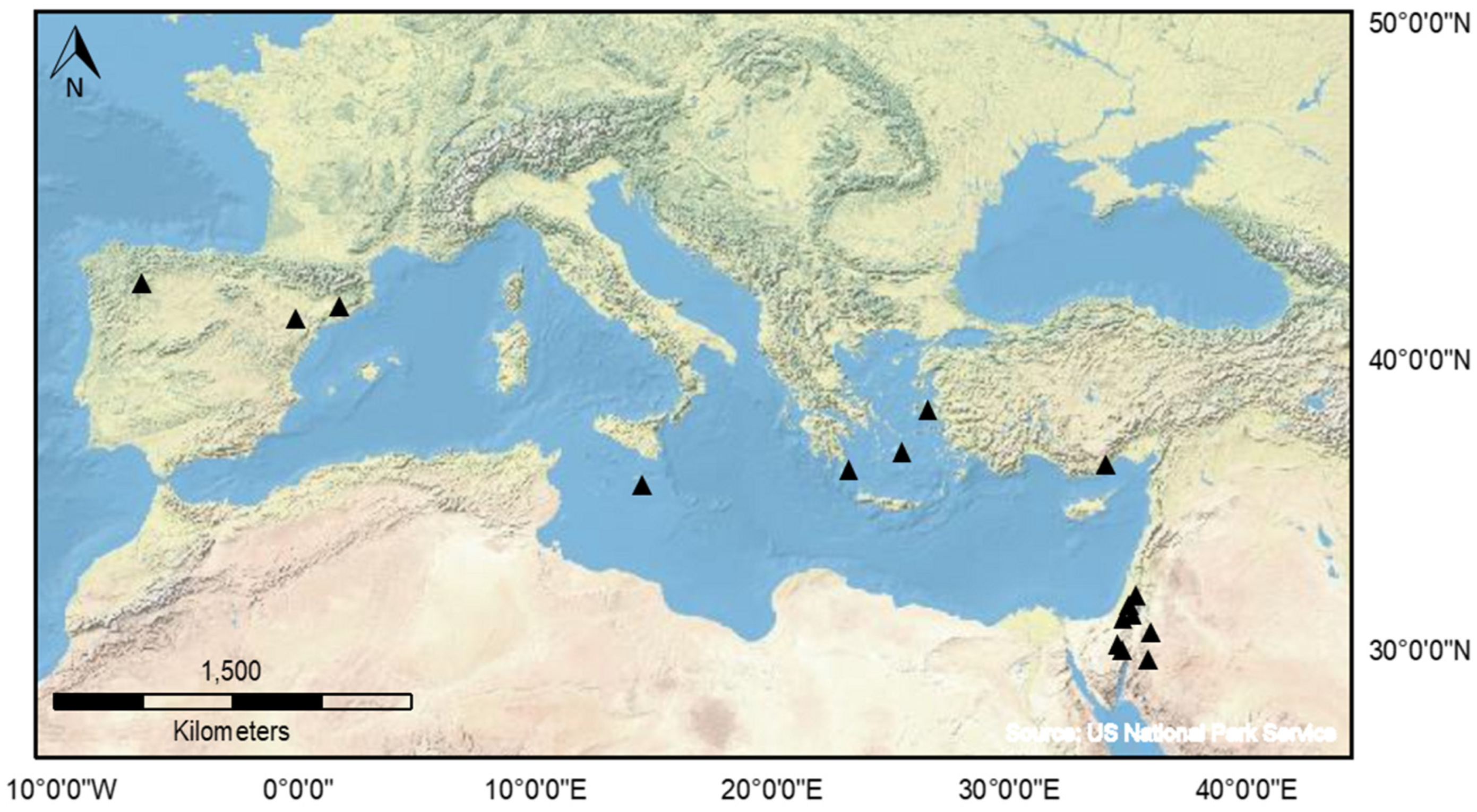
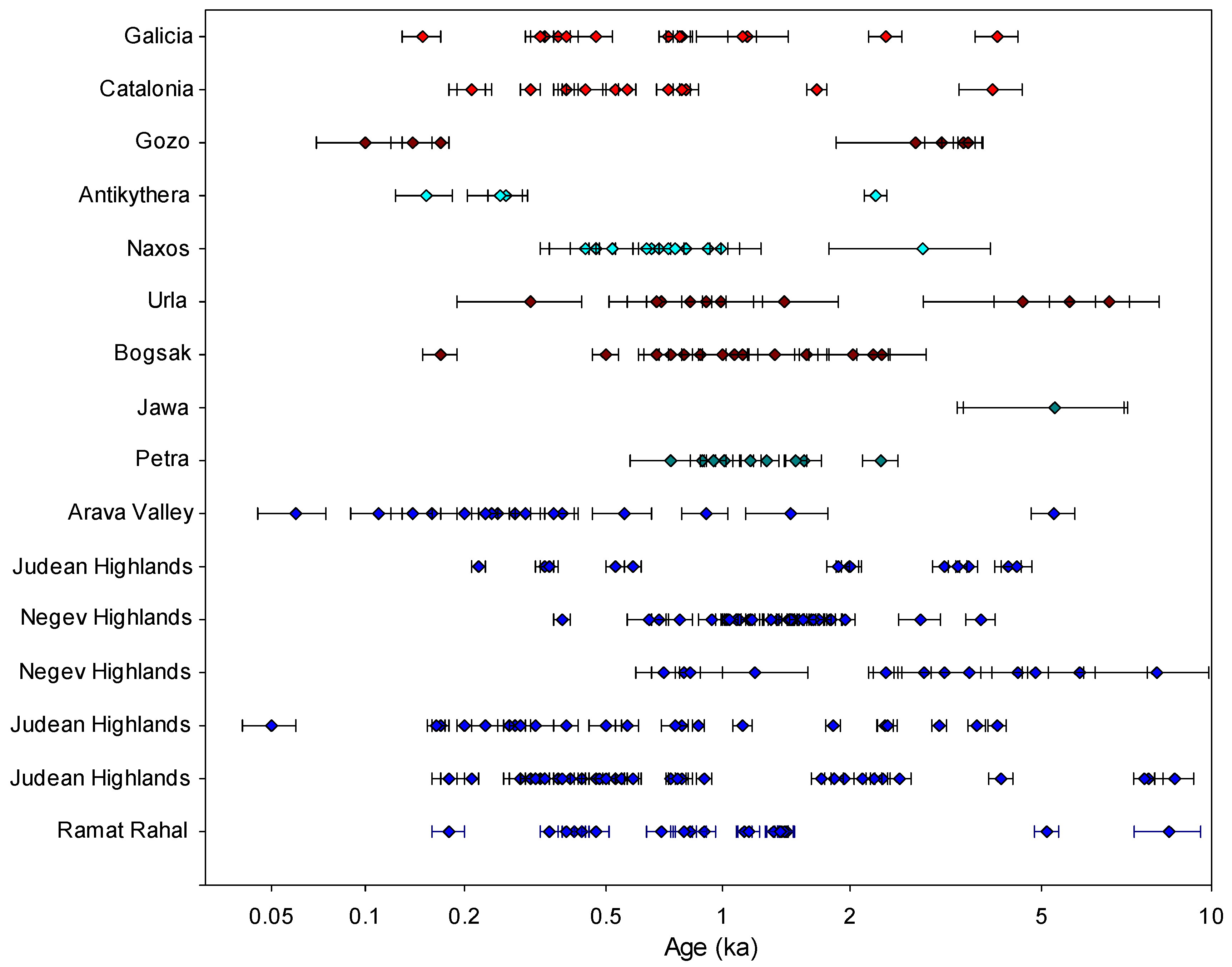
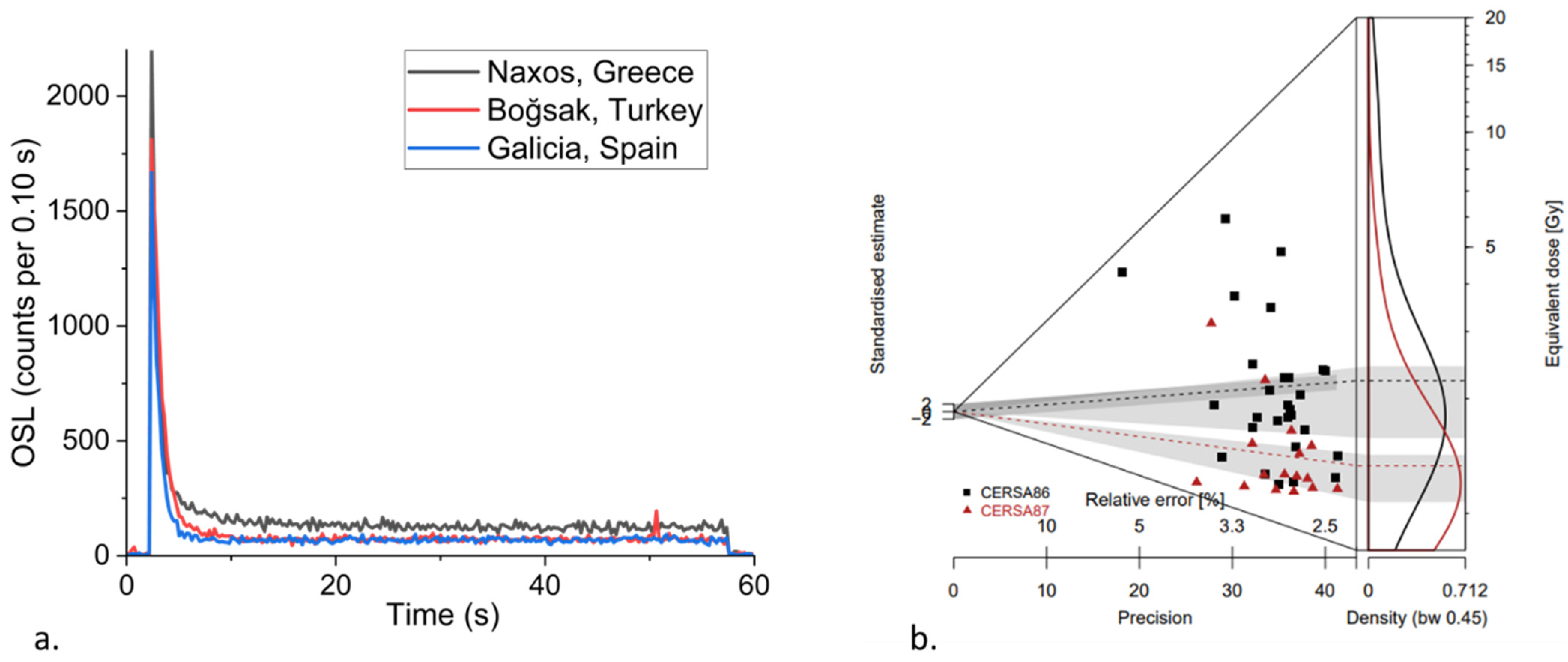

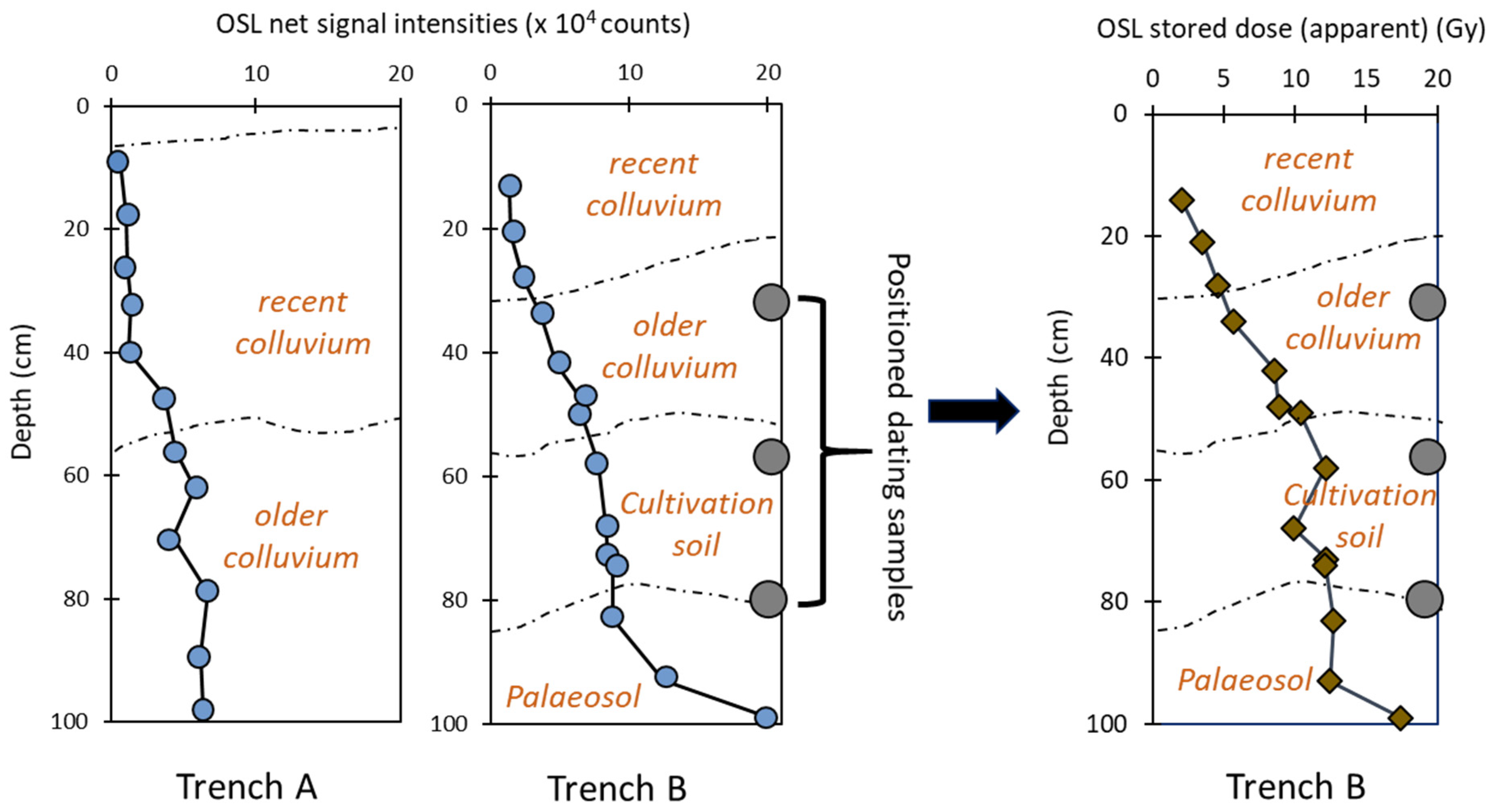
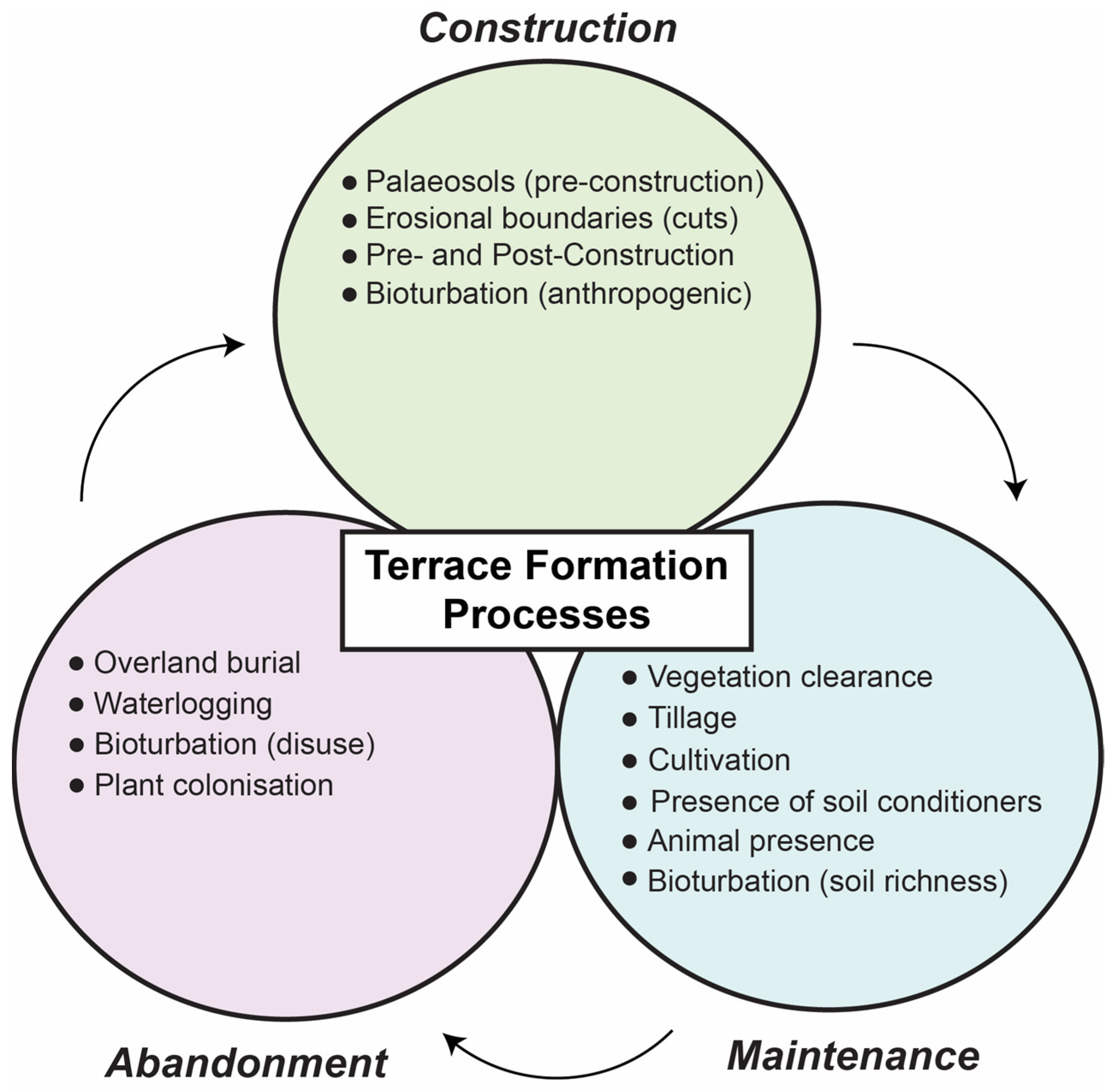
| Region | Country | OSL (#) | Reference |
|---|---|---|---|
| Catalonia | Spain | 15 | Kinnaird et al. [56] |
| Galicia | Spain | 15 | Turner et al. [69] |
| Gozo | Malta | 8 | French et al. [70] |
| Antikythera | Greece | 4 | Bevan et al. [7] |
| Cyclades | Greece | 12 | Turner et al. [69] |
| Boğsak | Turkey | 14 | Turner et al. [69] |
| Urla | Turkey | 10 | Turner et al. [69] |
| Negev Highlands | Israel | 17 | Avni et al. [64] |
| Negev Highlands | Israel | 31 | Avni et al. [65] |
| Arava Valley | Israel | 18 | Stavi et al. [68] |
| Judean Highlands | Israel | 23 | Gadot et al. [66] |
| Judean Highlands | Israel | 41 | Gadot et al. [52] |
| Judean Highlands | Israel | 21 | Davidovich et al. [62] |
| Judean Highlands | Israel | 13 | Porat et al. [67] |
| Petra | Jordan | 10 | Beckers et al. [54] |
| Jawa | Jordan | 2 | Meister et al. [63] |
Disclaimer/Publisher’s Note: The statements, opinions and data contained in all publications are solely those of the individual author(s) and contributor(s) and not of MDPI and/or the editor(s). MDPI and/or the editor(s) disclaim responsibility for any injury to people or property resulting from any ideas, methods, instructions or products referred to in the content. |
© 2023 by the authors. Licensee MDPI, Basel, Switzerland. This article is an open access article distributed under the terms and conditions of the Creative Commons Attribution (CC BY) license (https://creativecommons.org/licenses/by/4.0/).
Share and Cite
Srivastava, A.; Kinnaird, T.; Sevara, C.; Holcomb, J.A.; Turner, S. Dating Agricultural Terraces in the Mediterranean Using Luminescence: Recent Progress and Challenges. Land 2023, 12, 716. https://doi.org/10.3390/land12030716
Srivastava A, Kinnaird T, Sevara C, Holcomb JA, Turner S. Dating Agricultural Terraces in the Mediterranean Using Luminescence: Recent Progress and Challenges. Land. 2023; 12(3):716. https://doi.org/10.3390/land12030716
Chicago/Turabian StyleSrivastava, Aayush, Tim Kinnaird, Christopher Sevara, Justin Allen Holcomb, and Sam Turner. 2023. "Dating Agricultural Terraces in the Mediterranean Using Luminescence: Recent Progress and Challenges" Land 12, no. 3: 716. https://doi.org/10.3390/land12030716
APA StyleSrivastava, A., Kinnaird, T., Sevara, C., Holcomb, J. A., & Turner, S. (2023). Dating Agricultural Terraces in the Mediterranean Using Luminescence: Recent Progress and Challenges. Land, 12(3), 716. https://doi.org/10.3390/land12030716









